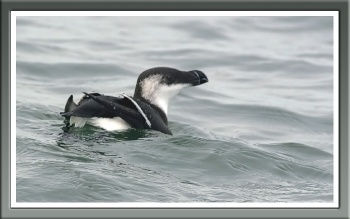- Alca torda
Identification
L. 37–39 cm (14½-15¼ in)
W. 60-69 cm
Adult Breeding
- Black upperparts
- White breast and belly
- Thick, black bill with blunt end
- White stripes on bill
- White line from eye to base of the bill
- Long, pointed tail
Non-breeding
- Black face becomes white
Similar Species
Common Guillemot, which has a long pointed bill.
Distribution
Northern Atlantic coasts, in eastern North America as far south as Maine, and in western Europe from northwestern Russia to northern France.
Taxonomy
Subspecies
Two subspecies are recognized:[1]
- A. t. torda - Northeast North America, Scandinavia to Murmansk and White Sea
- A. t. islandica - Iceland and British Isles to France; migrates to Mediterranean in winter.
Habitat
Breeds on islands, rocky shores and steep cliffs, usually at a lower level to the Common Guillemot. Winters on the open sea and in large estuaries.
Behaviour
Flight
Flies fast and direct low over water.
Breeding
In colonies with eggs laid on a bare rock ledge
Diet
Swims underwater to forage for food. Eats sand eels, herring, some crustaceans and marine worms.
Vocalisation
A querrulous, croaking kaargh
References
- Del Hoyo, J, A Elliott, and D Christie, eds. 2007. Handbook of the Birds of the World. Volume 12: Picathartes to Tits and Chickadees. Barcelona: Lynx Edicions. ISBN 978-8496553422
- Clements, J. F., T. S. Schulenberg, M. J. Iliff, D. Roberson, T. A. Fredericks, B. L. Sullivan, and C. L. Wood. 2017. The eBird/Clements checklist of birds of the world: v2017, with updates to August 2017. Downloaded from http://www.birds.cornell.edu/clementschecklist/download/
- Collins Pocket Guide to British Birds 1966
- Collins Field Guide 5th Edition
- Collins Bird Guide ISBN 0 00 219728 6
Recommended Citation
- BirdForum Opus contributors. (2025) Razorbill. In: BirdForum, the forum for wild birds and birding. Retrieved 11 May 2025 from https://www.birdforum.net/opus/Razorbill
External Links
GSearch checked for 2020 platform.1






